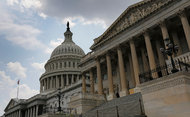 Jonathan Ernst for The New York TimesRepublicans and Democrats in Congress have both expressed a desire to reduce the corporate tax rate.
Jonathan Ernst for The New York TimesRepublicans and Democrats in Congress have both expressed a desire to reduce the corporate tax rate.
Republicans and Democrats have both expressed a desire to reduce the corporate tax rate from 35 percent to something in the neighborhood of 25 percent, which would be more in line with our major trading partners. The recent attention to the legal loopholes employed by Apple, Google, Starbucks and other multinational corporations to reduce their taxes could threaten the prospects of reducing the corporate rate.
While lowering the corporate rate remains good public policy, the optics have changed. It feels a bit like putting up a yield sign because cars keep running the stop sign.
But the importance of the corporate tax rate goes beyond offshore tax games. A draft paper by Thomas Hemmelgarn and Daniel Teichmann highlights the relationship between corporate tax rates and bank stability. Our tax code, like that of many countries, has a bias for debt over equity: interest payments to bondholders are deductible to the corporation, but dividend payments to shareholders are not.
Standard Deduction
View all posts
Corporations thus have an incentive to raise capital by selling bonds rather than equity. Debt payments reduce the amount of corporate tax that a company has to pay, leaving more left over for the shareholders.
Economists refer to this effect as the “debt tax shield.” Because the value of the tax shield is a function of the corporate tax rate, the value of the tax shield goes up as corporate tax rates go up.
The bias for debt over equity is especially troubling in the context of banks. Banks are distinctive because a bank failure, unlike an ordinary corporate bankruptcy, can cause other financial institutions to fail, creating social costs that go far beyond the banks’ shareholders, bondholders and employees. The less equity a bank has, the less stable it is, as it has less of a cushion to absorb losses.
Of course, bank executives also have nontax incentives to prefer debt to equity, as debt magnifies the upside for executives if the bank does well (and other parties, including the public, bear much of the downside risk if a bank fails).
In the paper, the authors look at statutory tax rate changes over a 12-year period in 87 countries to see how those rate changes affected banks’ capital structure. They find that a 10 percentage point increase (or decrease) in tax rates is associated with a 0.98 percentage point increase (or decrease) in the amount of debt in the capital structure. The authors control for a number of variables that would tend to affect capital structure, like bank size, regulatory requirements, overall economic environment, availability of deposit insurance, and so on. The authors also find that dividend payouts increase after a rate change, further reducing the equity on the balance sheet. Their findings are consistent with prior research, although the magnitude of the effect is a bit smaller.
But we should not scoff at the magnitude of the result. The implication is that reducing the United States corporate tax rate from 35 percent to 25 percent would lead to an average increase in bank equity of about 1 percentage point — to about 12 percent equity, from 11 percent.
One caveat is that the effect might be smaller for our largest and most systemically important banks, which tend to have other gimmicks available to reduce taxes. But considering the questionable track record of requiring responsible equity cushions through the multilateral Basel accords, reducing the corporate tax rate is a self-help technique Congress should consider, particularly if the revenue can be partly made up by reducing other corporate tax expenses.
If a corporate tax rate change is indeed on the horizon, analysts should watch banks’ balance sheets carefully. The paper confirms findings from previous research suggesting that banks will accelerate the recognition of tax losses before the rate change by increasing loan loss reserves before the change, effectively shifting corporate income forward to the lower-taxed period.
The aggressive gamesmanship by multinational corporations like Apple is disappointing, but it is not enough to simply say that we should close loopholes and keep the corporate rate high. The goal of bank stability should inform our decision-making about the design of the corporate tax, including the rate structure.
For further reading, see Thomas Hemmelgarn Daniel Teichmann, Tax Reforms and the Capital Structure of Banks (draft). On the social costs of excessive bank leverage, see Anat R. Admati et.al, Fallacies Irrelevant Facts, and Myths in the Discussion of Capital Regulation: Why Bank Equity Is Not Expensive (2011).
Victor Fleischer is a professor at the University of Colorado Law School, where he teaches partnership tax, tax policy and deals. Twitter: @vicfleischer
Article source: http://dealbook.nytimes.com/2013/05/30/reducing-the-corporate-tax-rate-could-stabilize-banks/?partner=rss&emc=rss
